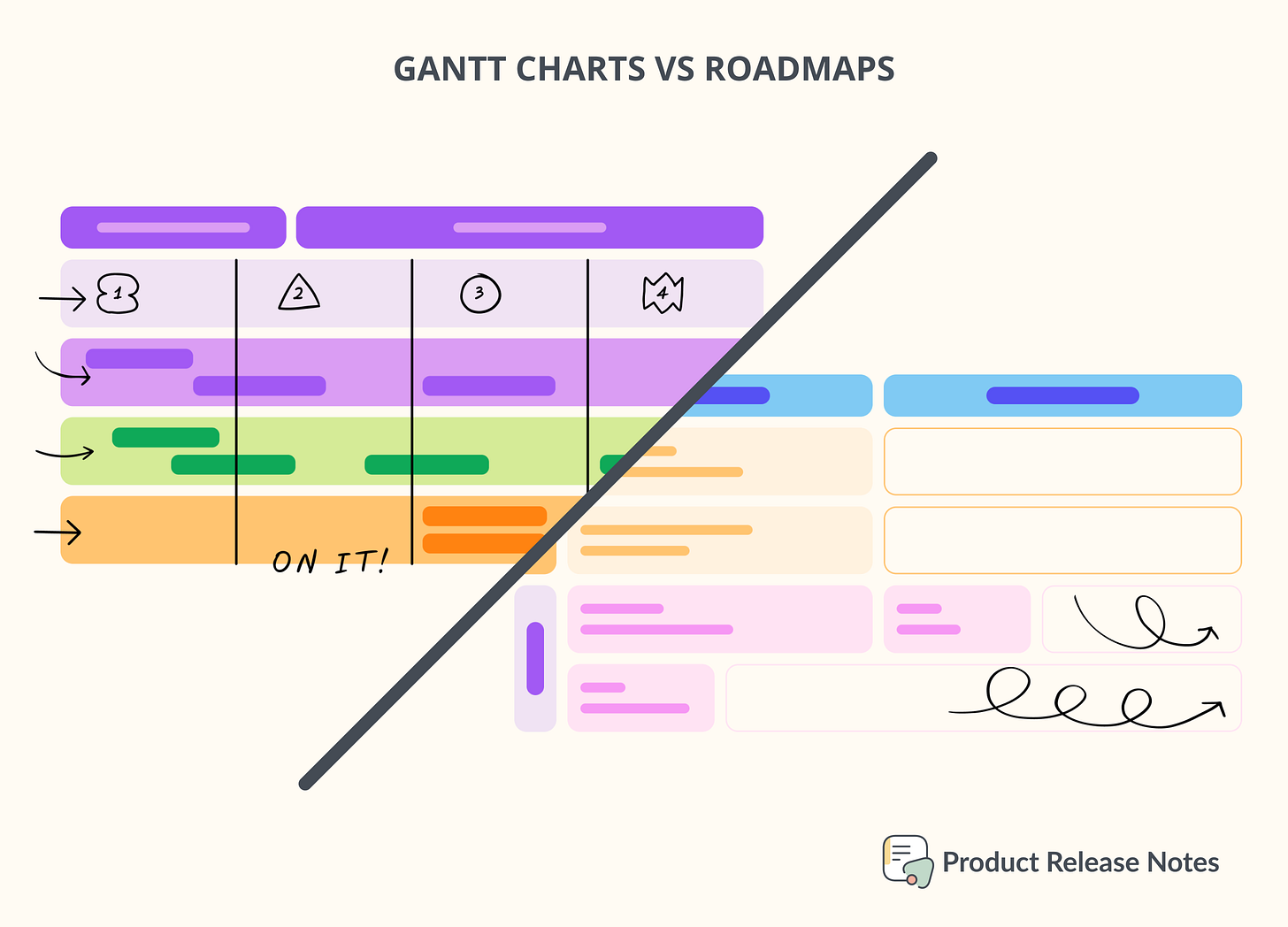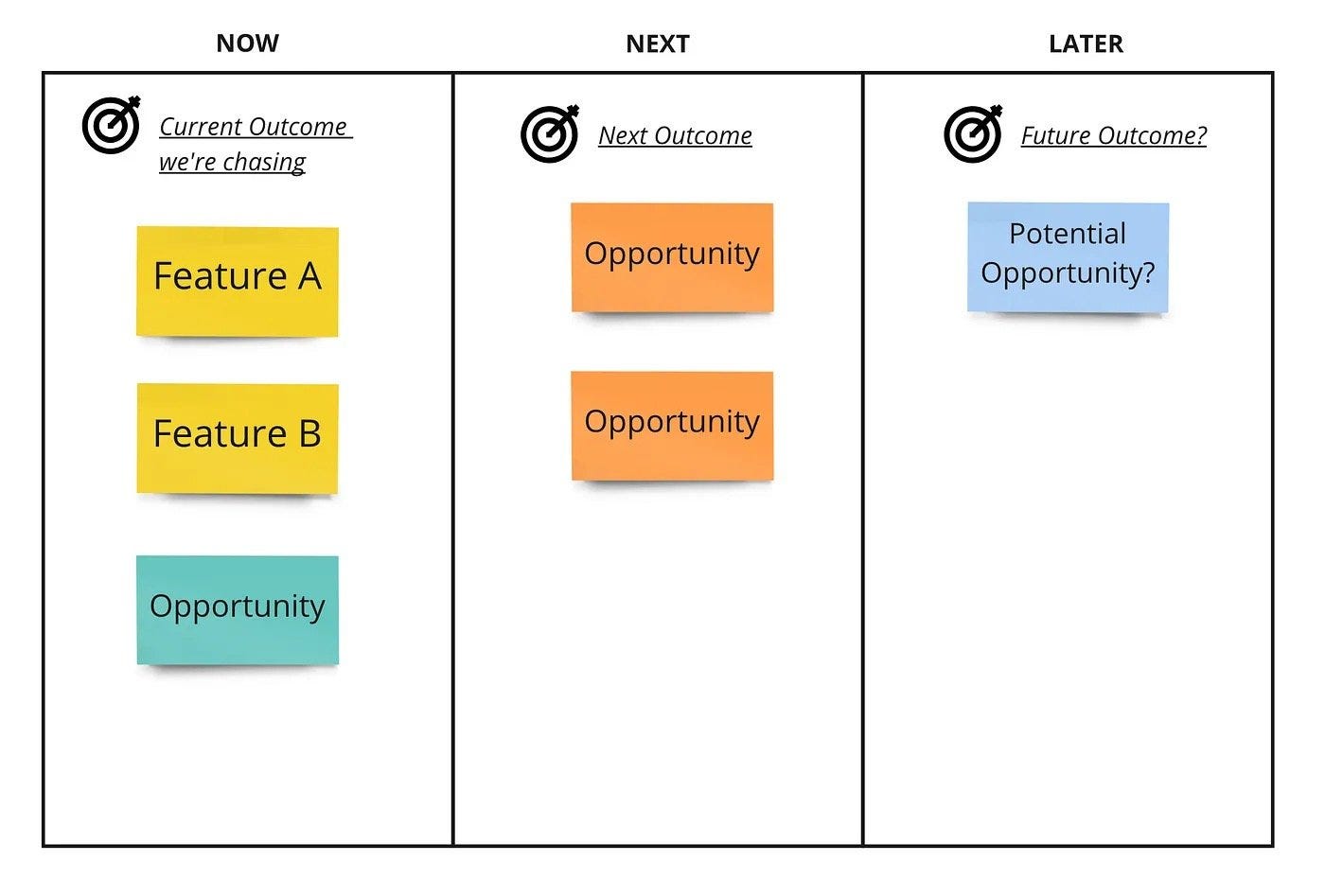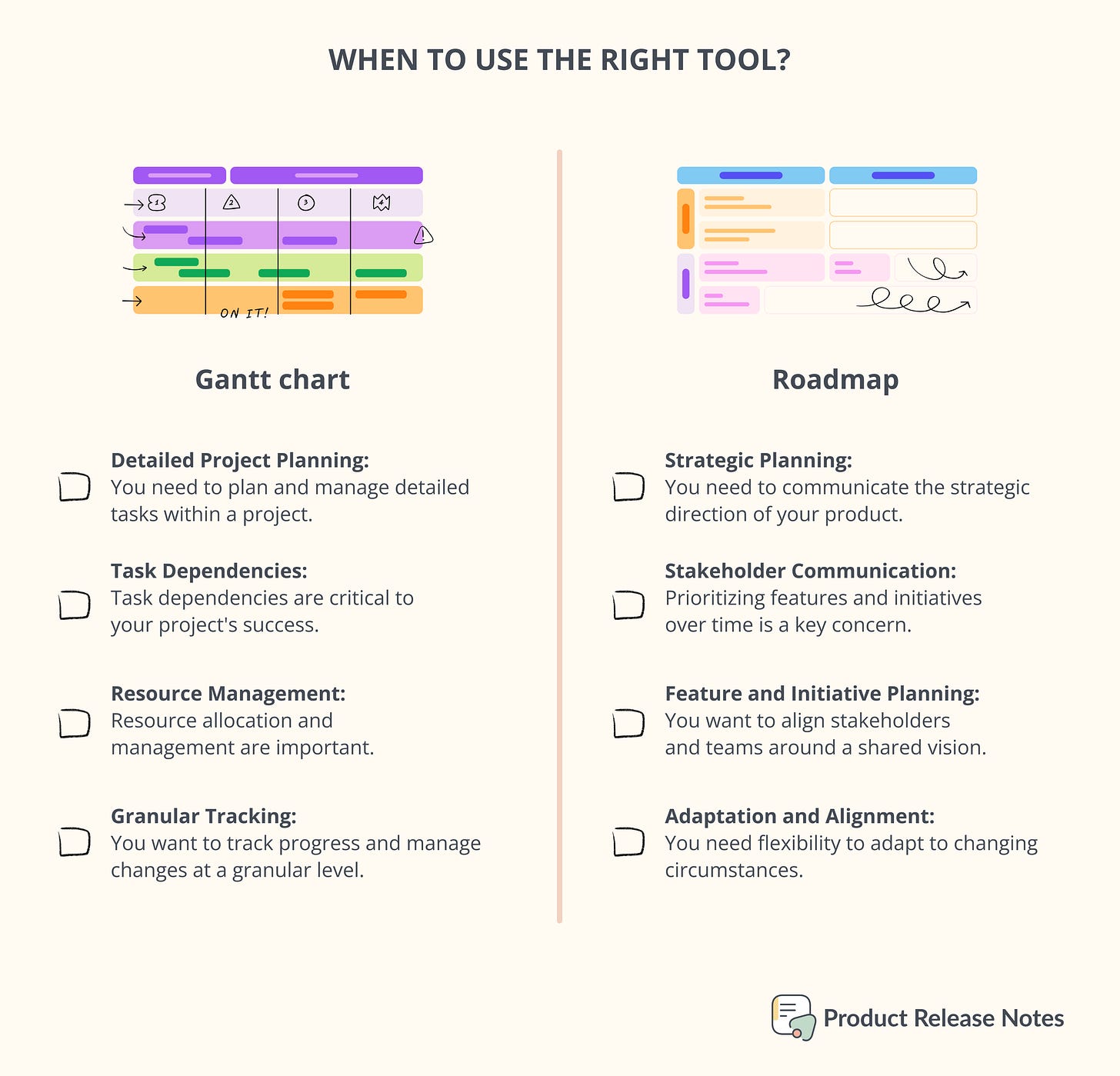Your Gantt Chart is NOT a Product Roadmap
Save your company time and budget by understanding the difference between Gantt charts and Roadmaps.
Believe it or not, my first introduction to roadmaps was something like this:
Boss: The executives are asking for a roadmap.
First time PM: Okay, what do we want to show?
Boss: Well, basically a timeline of our tasks. Do you know Gantt charts, right?
Although it may be confusing, Gantt charts and product roadmaps are not the same thing. Both tools use similar elements like milestones and accommodate elements through time, yet the difference resides in their purpose.
What is a Gantt chart?
A Gantt chart is a visual representation of project tasks and their corresponding timelines. It allows to plan, schedule, and track progress by breaking down the project into individual tasks and assigning them to specific resources.
Common characteristics of this tool are:
Displaying tasks as horizontal bars along a timeline, with their length representing the duration of the task and their position indicating when they should start and end.
Clarifying dependencies between tasks, identify potential bottlenecks, and allocate resources effectively.
Monitoring task progress, tracking deadlines, and identifying deviations from the original plan.
Gantt charts are useful for cross-functional teams. They clarify what work needs to be done first and in what order before moving to the next iteration. This tool is an action plan on how to complete the work for a project.
What is a Product Roadmap?
On the other hand, a product roadmap is a strategic document that outlines the high-level goals and direction for a product. Serves as a communication tool for product managers to align cross-functional teams, manage stakeholder expectations, and prioritize feature development based on market demands and business objectives.
Unlike a Gantt chart, a product roadmap is not focused on the minute details of project tasks or resource allocation. It conveys the big picture and strategic direction of the product, allowing stakeholders to understand the overall vision and plan for its development.
Common characteristics of this tool are:
Tells the high-level plans (the why) instead of the details (the how).
Communicates the product vision, major milestones, and planned features or enhancements over time.
Aligns stakeholders and provides a visual representation of the product's future trajectory.
When to use the right tool?
The decision to use a Gantt chart or a product roadmap depends on the purpose and stage of your project or product development. Each tool serves a different function, and understanding the characteristics of each will help you determine which one is more appropriate for your situation:
Gantt Chart
Detailed Project Planning: Gantt charts are excellent for detailed project planning. If you need to manage tasks, dependencies, timelines, and resources within a project, a Gantt chart is a suitable choice. It's particularly helpful for breaking down complex projects into manageable tasks and tracking progress.
Task Dependencies: Gantt charts allow you to visualize task dependencies and the critical path of a project. This is crucial for understanding which tasks need to be completed before others can start.
Resource Management: If your project involves managing resources such as people, equipment, and materials, a Gantt chart can help you allocate resources efficiently.
Granular Tracking: Gantt charts are great for tracking the actual progress of tasks, adjusting timelines, and managing changes throughout the project lifecycle.
Use a Gantt Chart When:
You need to plan and manage detailed tasks within a project.
Task dependencies are critical to your project's success.
Resource allocation and management are important.
You want to track progress and manage changes at a granular level.
Product Roadmap
Strategic Planning: Product roadmaps are designed for high-level strategic planning. If you want to communicate the vision, goals, and long-term direction of your product, a roadmap is the right choice.
Stakeholder Communication: Roadmaps are excellent communication tools to align teams, executives, investors, and customers around your product's vision and strategic priorities.
Feature and Initiative Planning: Roadmaps focus on features, initiatives, and major milestones. They provide a big-picture view of where your product is headed and help you prioritize what to work on next.
Adaptation and Alignment: Product roadmaps allow you to adapt to changing market conditions, user feedback, and business priorities by adjusting your plans accordingly.
Use a Product Roadmap When:
You need to communicate the strategic direction of your product.
Prioritizing features and initiatives over time is a key concern.
You want to align stakeholders and teams around a shared vision.
You need flexibility to adapt to changing circumstances.
In some cases, both tools can complement each other. You might start with a Gantt chart for detailed project planning during the execution phase and then use a product roadmap to provide a broader strategic context. The choice ultimately depends on your specific goals, the stage of your project, and the level of detail you need to convey.
“I have a Gantt chart, how can I convert it to a Roadmap?”
Converting a Gantt chart into a real product roadmap involves translating the timeline and tasks depicted in the Gantt chart into a strategic plan that outlines the overall direction, goals, and priorities for your product's development. Here's a step-by-step guide to help you achieve this:
Step 1: Understand the Difference
First, it's important to understand the distinction between a Gantt chart and a product roadmap. As mentioned above, a Gantt chart is a visual representation of project tasks and their timelines, while a product roadmap is a higher-level strategic plan that communicates the product's vision, goals, and key initiatives over time.
Step 2: Extract Key Information
Review your Gantt chart and extract key information such as project phases, tasks, milestones, timelines, and dependencies. Identify the most important elements that need to be carried over to the product roadmap.
Step 3: Define Product Vision and Goals
Start by outlining the general vision for your product. What problem does it solve? What value does it bring to users? Define clear, concise goals that align with the vision. These goals will shape the content of your product roadmap.
Step 4: Prioritize Initiatives
Based on the tasks and phases from your Gantt chart, identify the initiatives that align with your product vision and goals. Prioritize these initiatives based on factors like customer impact, strategic importance, technical feasibility, and business value.
Step 5: Create Timeframe Segments and Map Initiatives
Translate the timeline from your Gantt chart into broader segments on the product roadmap. These segments could represent quarters of the year or other relevant timeframes.
Prioritized initiatives onto these timeframe segments based on when they're planned for execution. Like Now-Next-Later roadmaps, that goes from the granular aspects to a broader high-level scope.
Step 6: Iterate and Update
A product roadmap is not set in stone. Make sure to continuously review and update it as circumstances change. New insights, market shifts, and feedback might require you to adjust priorities and initiatives.
Enjoying this issue? Share it with a friend!
The cost of confusing Gantt charts with product roadmaps
“What if my company does not do it that way? What if this is not what my manager asked for?” I get it. Maybe you’re in a situation where your company has confused Gantt charts with roadmaps for a long time, but as Product Managers it’s entirely up to us to educate and push things to the right direction. This is beneficial not only for your team but your company.
Confusing Gantt charts with product roadmaps can have several negative consequences like leading to miscommunication and misunderstanding among team members and stakeholders. Let’s take a deeper look:
Vagueness and non-direction
If a product manager presents a Gantt chart as a product roadmap, stakeholders may not fully grasp the strategic direction and overall vision of the product. This can result in misaligned expectations and priorities, leading to wasted time and effort on tasks that may not contribute to the product's success.
Lack of creativity and innovation
Additionally, using a Gantt chart as a product roadmap can limit creativity and innovation. Gantt charts are focused on task-level details and timelines, which can restrict the ability to think strategically and explore new opportunities. Product roadmaps, on the other hand, provide a broader view of the product's future trajectory, allowing for flexibility and adaptability in response to market demands and changes.
Poor resource allocation
Furthermore, confusing these two tools can hinder effective resource allocation. Gantt charts are designed to allocate specific tasks to resources, ensuring efficient project execution. However, product roadmaps prioritize feature development based on market demands and business objectives, which may require different resources or skills.
By using a Gantt chart as a product roadmap, resource allocation may not align with the strategic goals of the product, leading to inefficiencies and missed opportunities.
Wrapping Up
In conclusion, it is important to recognize that a Gantt chart and a product roadmap serve different purposes in the PMing world. While both tools can be used in product management, their purpose and level of detail differ significantly.
Gantt charts are more suitable for project planning and tracking, providing a granular view of task dependencies and resource utilization. Product roadmaps, on the other hand, are more strategic in nature, focusing on high-level goals and market-driven features to drive the long-term vision and success of a product.
And remember, a product roadmap is a communication tool! Share it with key stakeholders, such as your team, executives, investors, and customers. Use the roadmap to facilitate discussions, gather feedback, and align everyone on the product's strategic direction.







Would you share an example of a good product roadmap?